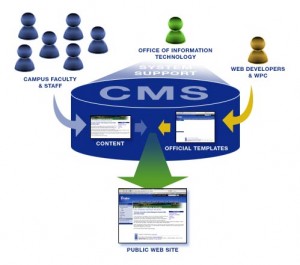Making a website can be a tedious project that incorporates many different facets of design and implementation. It may require that you learn the different web software and programming languages outlined previously. There are also just as many books on the subject as there are websites online.
 This is why web design firms charge so much money to build a website. However, it doesn’t have to be expensive to start (or re-design) your website. You can now use a “cookie-cutter” backend structure to manage and maintain your content. Welcome to the world of CMS–or more specifically in this case, webCMS.
This is why web design firms charge so much money to build a website. However, it doesn’t have to be expensive to start (or re-design) your website. You can now use a “cookie-cutter” backend structure to manage and maintain your content. Welcome to the world of CMS–or more specifically in this case, webCMS.
What is CMS?
Simply put, it’s a set of tools and/or software that is used to organize content for projects, presentations and reports while allowing multiple people to have access to these tools, add their own ideas, content and essentially just collaborate. For a website, think of it as a container or base structure for the content of your site. It’s wrapped with a theme of some sort and it allows you to focus on your content rather than your design.
There are a few types of systems you can get, but the most common is blogging software. A lot of people don’t consider a blog system part of the CMS group of software, but I do. The reason for this is because to me, it manages content–and pretty well I might add.
How does it work?
After your chosen software is installed, you’ll have access to an admin interface that allows you to configure and customize your new site. You can change the design, add themes, format text, setup categories, create static pages, manage uploads and downloads and create users. Here’s the basic breakdown of what a CMS is:
- Templates – The base structure to your site is accomplished through the use of templates. These files (XML or HTML) are stored in a central location and they apply design traits to all content pages on your site. This allows you to edit or change your “theme” instantly and across all pages at once.
- Editable Content – Because the content is not being stored in the design templates, it is easily edited using built-in content editors known as WYSIWYG editors. They contain basic formatting tools to make your content look nice and stand out.
- Scalable Features – Most CMS software packages are compatible with plugins that add or enhance features of the system to allow your site to grow as needed. These plugins are often designed by the user community and are usually free.
- Standards Upgrades – To keep up with web standards, popular CMS software programs are consistently updated and supported.
- Workflow – If there are multiple contributors on one site, content can be written, but not published until it’s been reviewed by the appropriate person.
- User Delegation – Users in the system can be delegated to specific roles that pertain to the various sections of the site. These users have only the access they need to get their work done.
- Document Management – As content and documents change, the entire revision history is available at all times to ensure that any changes are properly recorded and can even be restored back if needed.
- Virtualization – Some CMS software programs have options that allow users to work in a virtualized environment so they can edit and create pages and see how they will look online before actually publishing them online.
- Syndication – All CMS programs offer the ability to syndicate your content. This is done through channels like RSS, email subscriptions or Atom data feeds.
Blogging
If you have ever seen a website hosted or designed on WordPress, you’ve seen a blog. Essentially, you install a small out of software (a few PHP files and folders) on your webserver, follow a simple install process and start blogging. It’s really that easy and that’s exactly why it was created.
You can use a blog for any type of web content, so don’t think that just because you installed a blog that you have to post things everyday or talk about your personal life! You’ll find blogs that sell products, offer downloads or just have nothing but galleries of pictures.
Putting it all together
Get yourself a content management system. You will save yourself some major headaches in the future if you start on the right foot now. Using WordPress as an example, here’s what you’ll need:
- Web hosting plan – Your web hosting plan needs to offer you the ability to have at least one SQL database and the ability to run PHP. Check out GoDaddy or MediaTemple for great pricing and service.
- WordPress software – WordPress is free and can be downloaded from wordpress.org.
- FTP client – You need to be able to upload your WordPress files to your server. Using an FTP client for this will make life much easier. You can get away without one, but you’ll need to learn how to use your online file manager.
- Website theme – Unless you want to spend your time making your own design, I’d suggest you look into getting a theme or two to spice up your website’s look. I’ve gotten themes from both Woothemes.com and TemplateMonster.com (search only for WordPress themes).
- Content – This is where your creativity comes in! Write your own stuff about things you care about. Make it original and make it interesting.
| << Back to Ruby on Rails | Forward to Customer Relationship Management (CRM) >> |
5 thoughts on “Site Creation – Content Management System (CMS)”